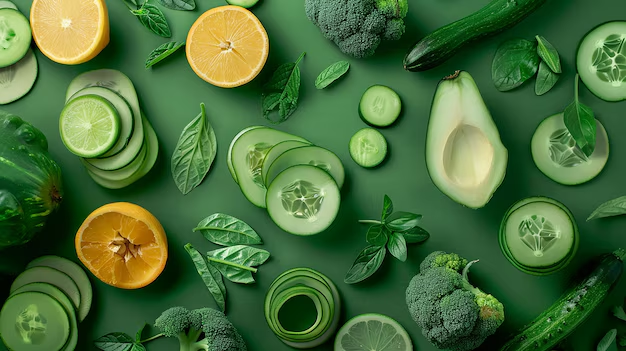Green food coloring is a popular choice for adding a touch of vibrancy to a wide range of food and beverages. Used to create everything from eye-catching desserts to seasonal beverages, green food coloring is a staple in kitchens and food manufacturing. In this blog, we’ll explore the uses of green food coloring, the types available, safety considerations, and natural alternatives that are gaining popularity.
The Appeal of Green Food Coloring
The color green is naturally associated with freshness, health, and nature. Foods colored with green are often perceived as nutritious, making them appealing to consumers. Green food coloring helps bring these associations to life in various products, especially in treats, beverages, and themed foods. Here are a few ways green food coloring is commonly used:
1. Baking and Confectionery: Green coloring is frequently used in treats like cupcakes, cookies, and frosting, especially during holidays like St. Patrick’s Day, Halloween, and Christmas. Green candies, mint-flavored sweets, and pistachio-flavored ice cream are some classic products that benefit from a touch of green.
2. Beverages: Green food color is often used in smoothies, cocktails, matcha-flavored drinks, and seasonal beverages. A hint of green adds a refreshing look to drinks, particularly those that use flavors associated with health or nature.
3. Processed Foods and Snacks: Green is a common color in snack foods and processed items like chips and cereal, where it enhances the visual appeal and gives the product a distinctive look.
4. Dairy and Plant-Based Products: Green food coloring is used in products like yogurt, cream cheese, and dairy-free alternatives, particularly for flavors like matcha, mint, and pistachio.
5. Pet Foods: Some pet foods and treats are colored green to signify vegetable flavors or simply to make them visually appealing to pet owners.
Types of Green Food Coloring
Green food coloring is available in both artificial and natural forms, each with unique characteristics and applications.
1. Artificial Green Food Colors
FD&C Green No. 3 (Fast Green FCF): This artificial dye is widely used in processed foods, ice creams, and beverages. It provides a stable, vibrant green hue that withstands different processing conditions. However, Green No. 3 is banned in some countries due to health concerns, so its use may be limited outside the U.S.
Blending Blue and Yellow Dyes: Another method involves combining yellow (such as Yellow 5) and blue (such as Blue 1) artificial dyes to create a range of green shades. This approach is popular in many candies, drinks, and baked goods.
2. Natural Green Food Colors
Spirulina Extract: Derived from a type of blue-green algae, spirulina extract is a common natural green colorant used in candies, drinks, and even some baked goods. It’s an excellent option for those looking for a natural, vegan-friendly alternative to synthetic green dyes.
Chlorophyll and Chlorophyllin: Chlorophyll is the green pigment found in plants, while chlorophyllin is a water-soluble version derived from chlorophyll. These pigments are widely used in health foods, smoothies, and salad dressings, as they offer a natural green color with antioxidant properties.
Matcha and Green Tea Powder: Used in everything from pastries to lattes, matcha powder is a natural green colorant that adds both color and flavor. It’s rich in antioxidants, making it a favorite among health-conscious consumers.
Spinach Powder: Made from dried, ground spinach, this powder is a mild-tasting green colorant ideal for pasta, baked goods, and savory dishes. It’s a go-to for those seeking a natural green color without altering the flavor too much.
Is Green Food Coloring Safe?
Green food colorings, both natural and artificial, are generally considered safe for consumption. However, there are specific considerations depending on the type:
1. Artificial Green Dyes: Some artificial dyes like Green No. 3 have raised health concerns due to potential adverse effects in sensitive individuals, including mild allergic reactions. In certain countries, artificial green dyes are banned or strictly regulated, prompting manufacturers to seek natural alternatives.
2. Natural Green Colorants: Natural green colors, such as spirulina and chlorophyll, are generally considered safer and are often used in products aimed at health-conscious consumers. Chlorophyll and chlorophyllin are approved for food use by the FDA, but some people may experience mild side effects if consumed in large quantities.
3. Clean Label Considerations: As consumers become more mindful of ingredients, the demand for clean-label products has increased. Natural green colorants align well with the clean-label trend, making them the preferred choice for manufacturers aiming to appeal to health-conscious and environmentally aware consumers.
Emerging Trends in Green Food Coloring
As the food industry evolves, manufacturers are responding to consumer demands for healthier, transparent ingredients. Here are a few key trends shaping the green food color market:
1. Clean Label and Natural Ingredients
With consumers increasingly concerned about synthetic additives, the preference for natural colorants, like spirulina and chlorophyll, has grown significantly. These clean-label options align with the health-focused, environmentally conscious lifestyles that many consumers aspire to.
2. Functional Food Colorants
There is growing interest in using colorants that offer more than Health And Fitness Flow aesthetic value. Ingredients like matcha, spirulina, and spinach not only add a vibrant green color but also provide health benefits, such as antioxidants and vitamins. This trend is particularly popular in the wellness and functional food markets.
3. Sustainable and Plant-Based Options
As more people embrace plant-based diets, demand for plant-based colorants, like chlorophyll and green tea powder, is on the rise. These options appeal to consumers seeking ethical and sustainable ingredients in their food.
4. Innovative Applications Beyond Food
Natural green colorants are finding applications beyond food, extending into cosmetics and even textile dyeing. Spirulina and chlorophyll, in particular, are popular choices for natural makeup products like eyeshadow and lipstick, offering an environmentally friendly and health-conscious alternative to synthetic dyes.
How to Use Green Food Coloring at Home
Whether you’re baking treats for a holiday party or experimenting with natural colors, here are some tips for using green food coloring at home:
For Natural Colors: Spirulina or matcha powder can be used to add green to smoothies, frostings, and cakes. Keep in mind that these powders can add a slight flavor, so use them in recipes where a hint of earthiness would be complementary.
Blending Blue and Yellow Colors: If you’re out of green coloring, you can mix blue and yellow dyes (either artificial or natural) to achieve a shade of green.
Chlorophyll for Smoothies: Chlorophyll is an easy, mild-tasting option to add a natural green to smoothies, juices, or even salad dressings. It’s available in liquid form at many health food stores.
Spinach Powder for Savory Dishes: Spinach powder works well in savory dishes like pasta, risotto, or soups, as it adds a green color without overpowering flavors.
Conclusion
Green food coloring plays a key role in food presentation, from festive baked goods to health-focused smoothies. As consumers lean toward healthier and environmentally friendly choices, natural green colorants like spirulina, chlorophyll, and matcha are becoming increasingly popular. These alternatives not only provide a natural look but often come with additional health benefits, making them a win-win for consumers and manufacturers alike.





